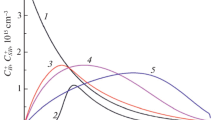Abstract
A new quantitative model of the latent accumulation of surface states in metal–oxide–semiconductor (MOS) structures after exposure to ionizing radiation and prolonged annealing is developed. The model is based on the formation of H+ hydrogen ions under exposure to ionizing radiation not only in a thin gate dielectric, but also in an adjacent thick field dielectric, and their subsequent dispersive transport to the interface with a silicon substrate. The density of latent surface states is defined by the Рb center passivation–depassivation balance equation at the SiO2–Si interface by hydrogen ions. The model allows us to explain the concomitant drop in the volume charge, as well as the decrease in the density of surface states (SS) after growth completion, and satisfactorily describes the experimental data.


Similar content being viewed by others
REFERENCES
K. I. Tapero, V. N. Ulimov, and A. M. Chlenov, Radiation Effects in Silicon Integrated Circuits for Space Applications (BINOM, Moscow, 2012) [in Russian].
J. R. Schwank, D. M. Fleetwood, M. R. Shaneyfelt, and P. S. Winokur, IEEE Electron Dev. Lett. 13, 203 (1992).
J. R. Schwank, D. M. Fleetwood, M. R. Shaneyfelt, P. S. Winokur, C. L. Axness, and L. C. Riewe, IEEE Trans. Nucl. Sci. 39, 1953 (1992).
G. S. Ristič, M. M. Pejovič, and A. B. Jakšič, J. Appl. Phys. 83, 2994 (1998).
G. S. Ristič, M. M. Pejovič, and A. B. Jakšič, J. Appl. Phys. 87, 3468 (2000).
O. V. Aleksandrov, Semiconductors 54, 233 (2020).
O. V. Aleksandrov, Semiconductors 55, 207 (2021).
V. I. Arkhipov and A. I. Rudenko, Philos. Mag. B 45, 189 (1982).
R. E. Stahlbush, A. H. Edwards, D. L. Griscom, and B. J. Mrstik, J. Appl. Phys. 73, 658 (1993).
A. Stesmans, Phys. Rev. Lett. 70, 1723 (1993).
J. Fishbein, J. T. Watt, and J. D. Plummer, J. Electrochem. Soc. 134, 674 (1987).
S. R. Hofstein, IEEE Trans. Electron Dev. 11, 749 (1967).
H.-E. Sasse and U. König, J. Appl. Phys. 67, 6194 (1990).
Y. Nissan-Cohen, Appl. Surf. Sci. 39, 511 (1989).
Author information
Authors and Affiliations
Corresponding author
Ethics declarations
The authors declare that they have no conflict of interest.
Additional information
Translated by A. Kazantsev
Rights and permissions
About this article
Cite this article
Aleksandrov, O.V. Latent Accumulation of Surface States in MOS Structures after Exposure to Ionizing Radiation. Semiconductors 55, 578–582 (2021). https://doi.org/10.1134/S1063782621070046
Received:
Revised:
Accepted:
Published:
Issue Date:
DOI: https://doi.org/10.1134/S1063782621070046




